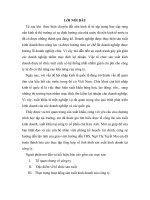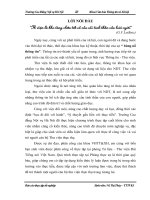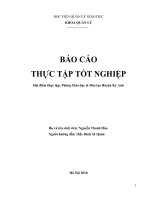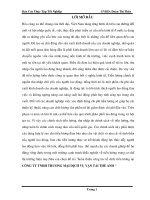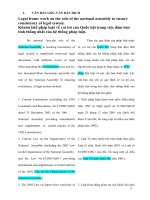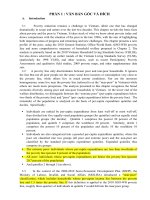Báo cáo thực tập tốt nghiệp tiếng anh (42)
Bạn đang xem bản rút gọn của tài liệu. Xem và tải ngay bản đầy đủ của tài liệu tại đây (120.31 KB, 22 trang )
ACKNOWLEDGEMENTS
I could not have completed my exercise without the enthusiastic help
and encouragement of my teacher, my friends, my parents, my mother’s
younger sister, as well as my classmates, special my teacher Mrs Nguyễn
Thị Vân Lam.
I would like to express my great graduation to Mrs Nguyễn Thị Vân
Lam, who gives useful advice for me to help choose suitable topic and
initiate the idea for my exercise and my mother’s younger sister who gives
introduction for me to complete this subject.
I also want to thank my teacher and best friend for guiding me to find
out necessary materials for my exercise.
Vinh, May 2010.
Tô Thi Thái
1
Abstract
English pronunciation is one of the important aspects in communication,
language teaching and learning. In this study, I only contrast phonetic
system between two languages generally. So, I just focus on main
similarities and differences and base on analysis segmental system and
suprasegmental system.
2
Table of contents
Acknowledgements
abstract
Table of contents
Part 1: introduction
1.1. The reasons of choosing this subject
1.2. Aims of the study
1.3. Methods of study
1.4. Scope of the study
1.5. Design of the study
Part 2: content
Chapter 1: phonetic – phonology
1.1. Linguistic and position of phonetic-phonology in the linguistics
1.2. Phonetic and phoneme
1.3. Definition of aspects of phonetic system
Chapter 2: The main similarities of phonetic system of English and
Vietnamese
2.1. Segmental system
2.2. Suprasegmental system
Chapter 3: The main differences of phonetic system between English
and Vietnamese
3.1. Segmental system
3.2. Suprasegment system
Chapter 4: Suggested practice
Part 3: conclusion
references
Part 1: introduction
3
1.1. reasons for choosing the subject.
Speaker of one language can not communicate with a speaker of
another one unless he had learned the other speaker’s language. If anyone
knows a foreign language knows its sound system well, it will help him or
her in of process of communicating. Like many other languages, phonetic
system of English and Vietnamese is both different and similar to each
other. For example, Vietnamese mainly depends on level tones such as “la,
là, lá, lả, lã, lạ ”, like a song but English does not have. English is called the
language intonation, which has particular intonation patterns, etc. These
differences make Vietnamese learners as well as English ones feel difficult
in using languages. Doing this study give us a good chance to investigate
main features of English and Vietnamese phonetic system so that we and
other Vietnamese learners can overcome difficulties in English phonetic
system and use its sound system well.
1.2 aims of the study.
The first aim of study is to analysis and compare the similarities and
differences of phonetic system between English and Vietnamese.
The second aim is to show some common problems that Vietnamese
learners meet when using English sounds.
The third aim is to give some suggested practice to improve the
learning of English phonetic for learners.
1.3 Methods of study
1.3.1. Contrastive and comparative method
1.3.2. Statistic method
1.3.3. Analysis and systematic method
1.4. scope of the study
The study only focuses the main simlilar and diffirent points
between English and vietnamese phonetic system.
1.5. design of the study
The study consists of three parts:
4
Part 1: introduction
Part 2: content
Chapter 1: phonetic – phonology
Chapter 2: the main similarities of the phonetic system of English and
Vietnamese
Chapter 3: the differences of the phonetic system between English and
Vietnamese.
Part 3: conclusion
Part 2: Content
5
Chapter 1: phonetics - phonology
1.1. Linguistics and the position of phonetic – phonology in
linguistics
Linguistics is defined as the scientific study of language which
includes:
Its sound – systems is called phonetics and phonology
Its word – structures is called morphology
Its sentence – structures is called syntax
Its word formation is called lexicology
Its word meaning is called semantics
Its social context is called socio – linguistics
So, phonetics is a branch of linguistics
1.2. Definition of phonetics and phoneme.
1.2.1. Phonetics
Phonetic is the study of how sounds are produced and how position
of mouth can be changed to produce different sounds.
1.2.2. Phoneme
Both phonetics and phonology study and describe the distinctive
sound units or morpheme of a language and their relationship to one
another.
A phoneme is the smallest unit of sound in a language which can be
used to distinguish words and word meanings.
Phonemes identify minimal pairs in a language.
For example: Car and Cat differ only in ending sound - /r/ and /t/ are
phonemes
1.2.3. Definitions of aspects in phonetics system.
1.2.3.1. Articulators
Articulators are parts of the vocal tract that move and change shape
to make sounds.
Both English and Vietnamese have articulators:
Nose (mũi )
upper teeth ( răng hàm trên )
Lower lip (môi trên )
lower teeth ( răng hàm dưới )
6
Lower lip (môi dưới )
alveolar ridge (lợi )
Tongue ( lưỡi )
hard palate ( ngạc cứng )
Soft palate ( ngạc mềm )
velum ( lưỡi gà )
Pharynx ( hầu )
larynx ( thanh quản )
1.2.3.2. Segmental
Means separated from the other parts, such as consonants, vowels,
syllables.
1.2.3.3. Consonants
A consonant is a sound in producing it, the air streams from the
lungs is stopped, impeded, constricted or other wise interfered with its
passage to the outside air.
Example: t, d, n, m, k , etc
1.2.3.4. Vowels
A vowel is a speech sound in which the air streams from lungs is
not blocked in any ways in the mouth or throat and which is usually
pronunced with vibration of the vocal cords.
Example: i, o, a, e, etc.
1.2.3.5. Syllables
A syllable is a speech unit consisting of a sound or a sound
sequence, one of which is heard to be prominent than the others.
Example: In English: car / ka: / → one syllable
Mother /mΛðә/ → two syllable
In Vietnamese: cô gái → two syllable
1.2.3.6. Suprasegmental
Means not being separated satisfactory, such as intonation, stress,
rhythm.
1.2.3.7. Stress
Stress is the emphasis given to a particular syllable within a word
or to a particular word within a group of words.
Word stress has three types of stress: primary stress, secondary stress and
unstressed.
7
Sentence stress has four types of stress: major sentence stress, major
word stress, minor word stress and unstressed.
1..2.3.8. Intonation
Intonation is the chaning of pitch pf speech, such as high, medium,
low.
1.2.3.9. Rhythm
Rhythm is defined as regular succession of stressed syllables and
unstressed syllables.
There are two kinds of speech rhythm: syllable – timed – rhythm
and stress – timed – rhythm.
1.2.3.10. Linking
Linking happens when we link groups of words together, usually for
ease of pronunciation
1.2.3.11. Elision
The nature of the elision is that in certain circumstances a phoneme
may be realised as zero, or have zero realisation or be deleted. Elision is
typical of rapid, casual speech
Chapter 2: The main similarities of phonetic system
between English and Vietnamese
2.1. Segemental system
2.1.1. The relationship between sounds and spelling systems
The same letter represents different sounds.
Example: In English: the letter “c” may represent /k/or /s/ sound
Ex: Class / kla:s / ; cup / kΛp /
Centre / sentә /
In Vietnamese:the letter “a” has three sounds
Ex: Xanh
/ε/
lao nhao
rau day
/а/ /а/
/ă/ /ă/
The letters may represent the same sound
Example: In English: the sound /f/ is represented by several letters
Ex:
Phone / fәυn / ; rough / rΛf / ; fun / fΛn /
8
Or the sound /u:/ is represented by other letters
Too / tu: / ; two / tu: / ; shoe / ∫u: /
In Vietnamese: the sound /k/ is represented by letters
Cá, cờ, kỳ, quen, quà, etc
Combinations of the letters may represent one sound
Example: In English: “oo”represents one sound / υ /: cook/ kυk /
good / gυd /
“ir” represents sound /з: /: bird/ bз:d /, girl / gз:l /
In Vietnamese: “ng” represents sound /ŋ/: nga, ngài,
“ph”
/f/: phố phường, phim
2.1.2. Consonants
Both English and Vietnamese use Roman alphabet, so there are
many
similar consonants in English and Vietnamese.
Example: b, c, t, g, etc
Consonants fall into classes according to the phonetic feature, that is,
according to how they are produced.
Manner of articulation
Stops/plosives ( âm tắc ): p, b, t, d
Fricatives (âm xát ): v, s, f
Nasal ( âm mũi ): m, n, ŋ
Affricates (âm tắc xát ): t∫ in English and “c” in Vietnamese
Lateral ( âm kề ): l
Place of articulation
Bilabials ( âm hai môi ): p, b, m
Labiodental ( âm mơi răng ): v
Velars ( âm vịm mền ): ŋ, k
Alveolars:t, s, l, n
Dental: θ
Palato – alveolar: t∫ in English, “c” in Vietnamese
State of the glottis
Voiced sounds: d, m, n, v, g, l
9
Voiceless sounds: t, p, k, s
Besides, English and Vietnamese have some similarities at some
particular consonants.
/p/ can stand at the and of a word
Example: In English: stop, cop, tip, sheep, etc.
In Vietnamese: cọp. cướp, xốp, etc.
/ŋ/ can occur in final position of English and Vietnamese
Example: In English: spring, ring, wrong, etc
In Vietnamese: thung lũng, nắng, chàng, nàng, etc.
2.1.3. Vowels
Both English and Vietnamese have short, long vowels and
diphthongs
Example: i, u, e, Iә, eI, aI → vowels in English
a, e, u, o, , → vowels in Vietnamese
In syllables, vowels are frequently the centre.
Example: In English: rub /rΛb/ ; duck /dΛk/
In Vietnamese: bạn, đến, làm, năm.
2.1.4. Syllables
Both English and Vietnamese have open and close syllables
Example: In English: open syllable: me /mi:/ ; Car /ka:/
Close syllable: back / bæk/
In Vietnamese: open syllable: ba /ba/ ; nga /ŋa/
Close syllable: em /εm/
The number of syllables in English and Vietnamese depends on the
number of vowels. It means that vowels are central factors of syllables.
Example: In English: attitude /ætitju:d/ has three vowels and three
syllables
A syllable must contains of least a vowel. A single vowel may be a
syllable in isolation
Example: In English: a/ә/ ; ah/a/ ; err /з:/
In Vietnames: ô /o/ (umbrella)
u /u/ (mother in the north)
10
In English and Vietnamese, syllables have characteristics:
An onset before the centre and no termination.
Example: In English bar /ba:/→ “b” is onset
Key /ki:/→ “k” is onset
In Vietnamese: me /mε /, thu /θu/ → “m”, “θ” are onset
No onset but a termination
Example: In English: am /æm/, earth /з:θ/, earn /з:n/
In Vietnamese: em /εm/, ung /uŋ/
Both onset and termination
Example: In English: run /rΛn/, Sat /sæt/
In Vietnamese: tin /tin/, tên /ten/
2.2. Suprasegmental system
2.2.1. Sentence stress
In a sentence, the stress is used to emphasize the important
informations and help to give special attention
Example: Emphasizing the subject which made action.
She hates cat→ “she” is stressed
Chính nó đã làm vỡ cốc → “chính nó” is stressed
Emphasizing the state of the subject
She loves him → “loves” verb is stressed
Tôi ghét hắn→ “ghét” verb is stressed
2.2.2. Intonation
Intonation is important in two languages. It is used to show different
colours or shade of meaning or feelings, such as surprise, dislike, disbelief,
belief or to distinguish communicative aims of sentence.
Example: In English:Don’t you know it ? ( question
Don’t you know it ? ( exclamation )
In Vietnamese: Mẹ đi chợ ( statement
Mẹ đi chợ ( question )
11
Chapter 3: The main differences of phonetic system
between English and Vietnamese
3.1. Segmental system
3.1.1. Sounds and letters
English: Sounds and letters are completely different
Example: book /bυk/
Chemistry /kemistri/
There are silent letters. It means that there are letters which
represent no sound
Example: knap /næp/ ; climb /klaim/
Vietnamese: Sounds and letters are similar
Example: bạn, bút, bảng, kỹ sư, etc.
The is no silent sounds. The sound is produced by the combination
of total number of letters.
3.1.2. Consonants
3.1.2.1. Number of consonants
English has( 24 consonants ) more consonant than Vietnamese (22
consonants)
3.1.2.2. Consonant clusters
There are consonant clusters in English, but is not in Vietnamese.
Consonant clusters can be in initial or final position. They are
divided in:
Initial 2 – consonant clusters: pl, pr ,bl, br, tr, tw, dr, kl, kr, gl, fl, fr,
sl, sp,st, etc.
Example: play, blue, stay, bring, snow, grow, fly, fry, etc.
Initial 3 – consonant clusters: spr, spl, str, scr, etc.
Example: spring, street, screw, splash, etc.
Final 2 – consonant clusters: mp, nt, nd, lp, ld, vt, rd, rl, rm, sp, st,
ect.
Example: jobs, bump, hand, cord, help, rent, etc.
Final 3 – consonant clusters: kθs, sks, lks, mpt, mst, nts, etc.
Example: sixths, desks, tempt, etc.
12
Final 4 – consonant cluster: mpts, lfθs
Example: twelfths, tempts
3.1.2.3. Some particular consonants
English: /p/ can occur in initial position
Example: pen, put, pound, pet, etc
/r/ is a vibrated sound
Example: rich, rice, rose, run, etc
Letter “ th ” can produced two sounds
/θ/ truth /truθ/ ; thin /θin/
/ð/ then /ðen/ ; there /ðeәr/ ; they /ðei/
/ŋ/ does not occur at initial position of word
Vietnamese:
/p/ does not occur in initial position of the sound system. It is only
used in final position to end a word.
Example: nháp, tấp nập, cọp, etc
Vietnamese replace /b/ or /t/ for /p/ when speaking English
Example: “put” can sound like as “foot”
“peter” can sound like as “beater”
/r/ does not a vibrated sound, it is a fricative sound. It means the
air is constricted causing friction when passing through the organs of
speech. It pronunced as /ʐ/,ex: rỗ, rá.
Letter “ th ” only produced one sound /θ/
Example: thu /θu/
/ŋ/ may appear in initial position of word
Example: nga /ŋa/, nghe /ŋε/, ngô /ŋo/
3.1.2.3. Vowels
3.1.2.3.1. The number of vowels
English: there are 25 vowels, including: 12 vowels:7 short vowels: i,e, æ, ә,
u, Λ, ɔ ; 5 long vowels: i:, u:, з:, a:, ɔ: ; 8 diphthongs: Iә, eә, υә, eI, aI, ɔI,
әυ, aυ; and 5 tripthongs: eIә, aIә, aυә, ɔIә, әυә.
Besides, it has semi – vowels (w, j ), such as, would /wυd/, you /ju:/
13
Vietnamese: there are 13 vowels, including: 9 short vowels: i, e, ε, u , , a,
, o, ; 4 long vowels: ǎ, , , ; 3 diphthongs ie, , uo.
Addition to, there are two semi – vowels , , ex: đại hội, huy, tuy,chơi, túi,
lấy.
3.1.2.4. Syllables
3.1.2.4.1. The number of syllable
English: is called language of multi – syllables. It means a word may have
one or more syllables.
Example: pen /pen/ → one syllable
improve /impru:v/→ two syllables
dictionary /dik∫әnәri / → three syllables
Vietnamese: is called language of mono – syllable because syllables are
produced separately. In a word, syllables exist isolation, a syllable can not
stand alone.
Example: giáo viên (not giáoviên) → two syllables
3.1.2.4.2. The relationship between syllables and morphemes
English: the number of syllable and the number of morpheme may be the
same or different. The is boundaries between syllables and morphemes of
word.
Example: girls /gз:ls/: two morphemes - one syllable
Opening /зυpәniŋ/: two morphemes - two syllables
There is no pause between syllables when producing sound and no space in
writing.
Example: table /teIbl/ not /teI bl/
Intelligent /intelidgәnt/ not /in tel li dgәnt/
Vietnamese: the number of syllable and morpheme is equal in a word (one
morpheme, one syllable in a word ) and there is no boundaries between
syllables and morphemes of words (a syllable is a relationship of a
morpheme)
Example: học sinh: two morphemes - two syllables
3.1.2.4.3. Open and close syllable
14
English: almost any consonant sounds can occur in final position of a close
syllable
Example: bad /bæd/ ; tap /tæp/ ; back /bæk/
The voiceless consonant sounds occurring at the end of the syllables are
always released.
Example: beat/bi:t/ ; meat /mi:t/
Vietnamese: only the voiceless consonant sounds /p/, /t/ and nasals /m/,
/n/ , /ŋ/,and /c/ are permitted in final position of closed syllables
Example: bạn, bác, bát, ngỗng(ŋ), tìm
The voiceless consonant sounds /p/, /t/ occurring at the end of syllable are
never released and much shorter than their English equivalence.
Example: xốp, xếp, tết, tấp nập
3.1.2.4.4. The internal structure of syllables
English:
Onset consonant
Pre
initial Post
-initial
-initial
s
L, r,
peak
vowel
Coda consonants
Pre
final
Post-
Post-
Post-
-final
final
final
final
w, j
S, z, t, d
Example: “smork” is the word which has one syllable: s- pre initial, minitial, o- vowel(peak), r- pre final (coda), k- final(coda)
Vietnamese:
Tone
Initial
rhyme
Inserted vowel
Main vowel
Final
( seni – vowels
consonants
or zero )
(semi – vowel
or zero)
Example: “Toàn”: T- initial consonant, o- inserted consonant, a- main
consonant, n- final consonant.
15
3.2. Suprasegmental system
3.2.1. Word stress
English: almost words have stress
Syllable is stressed which spoken loudly and strongly, the syllable is not
stressed which is glided
Example: potato /pә′teitәυ/ the second syllable is stressed and the first and
the third syllable is unstressed.
Comfort /′cΛmfәt/ the first syllable is stressed, the second
syllable is not stressed, and is spoken glided.
Word is stressed differently made different cognition
Example: present /prezәnt/ → the word has two syllables.
If the first is stressed /′prezәnt/, it is noun
If the second is stressed /pre′zәnt/, it is verb
Vietnamese: word is no stress because most of words in Vietnamese is one
syllable word.
3.2.2. Weak and strong form
English: strong and weak syllables is one of the most noticeable feature of
English. They are terms to refer to phonetic characteristics of syllables,
There are two major factors in determinering whether a syllable will be
strong or weak: stress and intonation.
Example: I’m looking for a job
/fər/ → weak form
A job is what I’m looking for
/f r/ → strong form
Vietnamese: there is no strong and weak form.
3.2.3. Sentence stress
English: when you speaking english, the word you stress can change the
underlying meaning of a sentence
A single sentence may have many levels of meaning based on the word you
stress. Important words, such as nouns, adjectives, adverbs, verbs are
16
stressed. The unimportant words, such as preposition, conjunction, article
are unstressed. Normally, the last important word in the sentence has the
most stress
Example: she is a nice girl.
Vietnamese: Vietnamese speaker only use stress in the words that convey
the important information
Example: Anh ta là giám đốc khách sạn này
3.2.4. Tones
English: does not use tones to distinguish word meanings but pitch
changes contribute significantly to the meaning of the whole sentences.
These changes in pitch in English occur over entire clauses or sentences
and different pitch patterns can signal very different meanings for the same
sentence.
Example: I would like to coffee (statement )
You would like to coffee ( question )
Vietnamese: use tones ( pitch levels) to signal differences in meaning
between words
Example: when tone is changed, the meaning of word will be changed
“mua” is different from “mùa”
3.2.5. Elision
English: there is elision which means under certain cases, sounds disappear
and create changes in pronunciation.
Example: “will” spelt 'll, pronunced /l/ (after vowels), ļ ( after consonants)
“have” spelt 've, pronunced /v/ ( after vowels ), әv ( after
consonants )
Vietnamese: there is no elision
3.2.6. Intonation
English: has particular patterns:
Falling intonation is used in: Statement, ex: I have a new car.
Wh – question, ex: where have you been?
17
Imperative, ex: bring your notes for text.
Rising intonation is used in: Yes / No questions
imperative as request or statements, as remarks of
any emotion, ex: Do you want to watch a movie?
Sustained intonation, ex: You love him, don’t you? ( yes, I love him )
You love him, don’t you?( yes or no )
Vietnamese: does not have any particular intonation patterns
Example: A: bức tranh đó đẹp nhỉ
B: đẹp
If B stretches her voice, it conveys negative meaning with uncomfortable
attitude
If the pitch is low and level, B actually admires its beauty.
Intonation is important to determiner particular meaning in Vietnamese
Example: Anh ta đánh / con rắn chết ( a )
Anh ta đánh con rắn / chết ( b )
( a ) the man continued striking the snake which was dead
( b ) the man who killed snake
3.2.7. Linking
English: there are links between words in sentence / clause because the
voiceless consonant sounds occuring at the end of the syllables are always
released.
Example: I arranged for a meeting in my office.
You should try it on before you buy it.
Vietnamese: there is no links between words in sentences / clauses because
the Vietnamese syllables are separated. If there is links the word meaning
will change completely
Example: êm ả ≠ ê mả
3.2.8. Rhythm
English: is the language which has the stress – time nature.
18
The rhythm of the speech is based on the minor stresses of the sentences.
This means lightened syllables may be pronunced very fast so as not to
break the particular rhythm
Example: it takes the same time to say through the number of syllables in
each sentence is very different
“ birds eat worms”
“ the birds will have eaten the worms”
Vietnamese: is the language which has the syllable – time nature
Example: it takes a shorter time to say “anh yêu em” ( a ) than to say “anh
sẽ mãi yêu em” ( b ) because the number of syllables of (a ) is greater than
that of ( b)
Chapter 4: Suggested practice
Exercise 1: Study the following sentences, mark stress and practice reading
aloud them
a. That patient has a bad headache.
b. This restaurant is very expensive.
c. His new car is small, fast and expensive.
d. They can take short messages for you.
e. The manager is holding a brief meeting.
Exercise 2: write the following words in phonetic transcription, according
to your pronunciation.
19
a. Fright
e. Unique
b. Broad
f. Mountain
c. Journalese
g. Climate
d. Volunteer
h. Perfect
Exercise 3: practice /θ/ & /ð/
Thumb
Although
Those
Method
Nothing
Than
Neither
Breather
Together
Theater
Mathematics
Exercise 4: give the rhythm of the exact of the follơing poem
Love’ s secret
William Balake
Never seek to sell why love,
Trembling, cold, in ghastly fears,
Love that never total can be;
Ah! She did depart!
For the gentla wind does moves
Soon as when was gone from me,
Silently, invisible;
A traveler came by,
I told my love, i total my love,
Silently, invisible;
I told her all my heart;
He told her with a sigh.
20
Part 3: conclusion
From above assignment, we can affirm once more time that English
phonetic system is rather various and complex and it makes difficulties for
teaching and learning English. In the scale of this study, I have tried my best
to present a general look on phonetic system of English as well as analysed and
contrasted main feature of phonetic system of English and Vietnamese. I hope
that it is will be an interesting and useful material for anyone who is engrossed
in English phonetic system.Besides, I suggested som posible types of exercises
that may be helpful for anyone who wants to master English phonetic system
in order to be successful and effective in using English. However, due to my
lack of experience as well as knowledge, the mistakes can not be avoidable.
So, I would like to receive the comment and advice from my teacher and
friends.
References
21
1. Beverly Beisbier. Sounds great.an international thomson publishing
company boston,massachusetts 02116 U.S.A.
2. Peter Roach (2007). English Phonetics and phonology. Ha Noi publishing
house.
3. Howard Jackson Etienne Ze Amvela. Words, meaning and vocabulary.
Cardiff university.
4. Nguyen Hoa.(2001). An Introduction to Semantics. Vietnam National
University.
5. Quoang Hung, Phuong Trang, Tran Thi Minh Nguyet.English – Vietnamese
Dictionary. Thanh Nien publishing house.
6. barker, A (1992), Inytroducing English pronunciation, Cambridge University
press,
7. Roach, P (2002). English phonetics and phonology: Apractice course.
Cambridge. Third edition. University,
22

